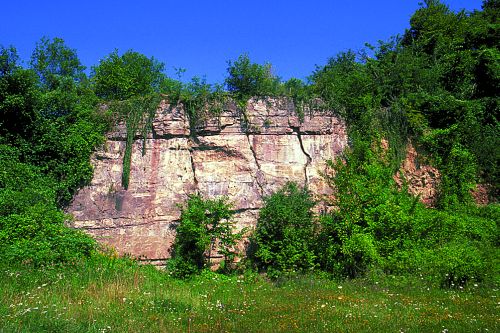

Der aufgelassene Steinbruch nordöstlich vom Stifterhof Odenheim (Ärarischer Steinbruch) erschließt eine mächtige Folge in der Schilfsandstein-Formation des Mittelkeuper in Flutfazies. Hier wurde ein hellbrauner, z. T. rötlich gefärbter und geflammter, feinkörniger, gut sortierter und überwiegend tonig gebundener Sandstein in meterdicken Bänke abgebaut. In der Wand sind Schrägschichtung und Strömungsrippel zu erkennen, daneben auch Rinnenstrukturen, in denen der sonst massige Sandstein dünnbankig bis blättrig wird. Stellenweise sind im oberen Bereich Wurzelröhren erkennbar. In der näheren Umgebung befinden sich weitere aufgelassene Steinbrüche im Schilfsandstein.
Entstehung und Alter
Der graugrüne bis rötlich-braune Schilfsandstein ist ein reifer Sandstein mit einer gleichmäßigen, feinen Körnung. Graue Tonflasern und Wellenrippel strukturieren die schwach verfestigten mittel- bis dickbankigen Sedimente. Der Gesteinsname weist auf Pflanzenfossilien von Schachtelhalmgewächsen hin, welche fälschlicherweise für Schilf gehalten wurden. Von Skandinavien her breitete sich ein verzweigtes Flußnetz bis nach Süddeutschland aus. Gelegentlich drang das Meer in die Flüsse ein. An der Basis schnitten die Sandsteinstränge tief in den unterlagernden Gipskeuper ein. Heute bilden diese Stränge Höhenrücken im Landschaftsbild des Kraichgau, z.B. Stromberg und Heuchelberg. Der Schilfsandstein ist ein Sediment des mittleren Keupers der Germanischen Obertrias mit einem Alter von etwa 225 Millionen Jahren.
Verwendung des Schilfsandsteins
Als Werkstein wurde der Schilfsandstein vornehmlich für Profilstücke an Gebäuden, aber auch für das Mauerwerk genutzt. Beispielsweise besteht der Vittali-Bau des 1911 bis 1913 erbauten Hauptbahnhofs in Karlsruhe aus Schilfsandstein. Durch die schwache, meist nicht kieselige Bindung ist der Schilfsandstein sehr verwitterungsanfällig und sandet stark ab. Deshalb wird dieser Sandstein heutzutage nicht mehr verbaut und alte Bausubstanz muss aufwendig saniert werden.
Logbedingungen:
1) Ermittelt die Antworten zu den beiden folgenden Fragen vor Ort
Schickt bitte vor dem Loggen Eure Antworten an meinen GC-Account und loggt direkt online; ich melde mich, falls es Probleme mit den Antworten geben sollte. Logs ohne Antwortmail werden gelöscht.
a) Welche Höhe zeigt Dein GPS an den oben angegebenen Koordinaten?
b) Wie hoch ist das Felsband ungefähr?
2 Es wäre schön, wenn Du Deinem Log ein Foto von Dir und Deinem GPS-Gerät mit einstellen würdest, bei dem man im Hintergrund das Felsband sieht.

English:
The abandoned quarry northeast of Stifterhof Odenheim (Ärarischer quarry) opens up a huge impact in the reed sandstone formation of the Middle Keuper Flutfazies. Here was a light brown, reddish-colored, partly dismantled and flamed, fine-grained, well sorted and mostly clay-bound in meter-thick sandstone beds. In the wall cross-bedding and current ripple can be seen, besides also channel structures in which the otherwise massive sandstone dünnbankig until flaky. In places are at the top of root tubes visible. In the vicinity are more abandoned quarries are located in the Red Sandstone.
Origin and age
The gray-green to reddish-brown Schilfsandstein is a mature sandstone with a uniform, fine grain. Grey Tonflasern and wave ripple structure the weakly solidified medium to fairly dense sediments. The rock name refers to plant fossils of horsetails, which were mistaken for reeds.
From Scandinavia spread a branched river network of up to southern Germany. Occasionally, the sea penetrated into the rivers ein.An the base of the sandstone columns cut deeply into the subjacent gypsum Keuper. Today, these strands form ridges in the landscape of the Kraichgau zBStromberg and Heuchelberg. The reed is a sedimentary sandstone of the middle Keuper of the Germanic Triassic with an age of about 225 million years ago.
Using the Schilfsandstein
As a stone of the reed sandstone was used primarily for profile pieces of buildings, but also for the brick work. For example, consists of Vittali-construction of the railway station was built from 1911 to 1913 in Karlsruhe Schilfsandstein. Due to the weak, the bond is not usually siliceous Schilfsandstein very prone to weathering and Sandet sharply. Therefore, this sandstone built these days and not more old buildings must be completely renovated.
If you want to log this earthcache:
1) You can find the answers to the questions on site.
Please prove your visit to this site by sending the answers to my GC.com account, then you may log, I will contact you in case of problems. Logs without an answer-mail will be deleted.
a) Which altitude is shown on your GPS at the above coordinates?
b) How high is the rock face approximately ?
2) It would be nice if you could set your log a photo of you and your GPS device, which can be seen in the background, the rock band.